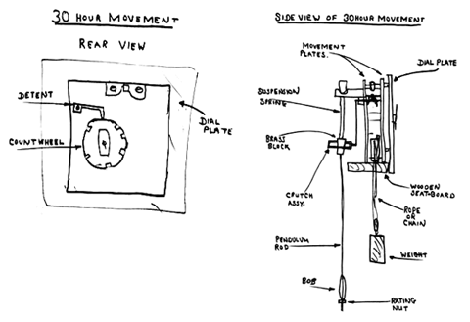Setting Up A Weight Driven Vienna Regulator
The clock should be hung on a strong screw fitted to the wall with a wall plug. The pendulum and pulleys may have been taped to the rear or sides of the case and should be released. Look through the glass sides to make sure both lines are still on their drums. The pendulum will act like a plumb line and the case can be moved until the bottom of the pendulum lines up with the centre of the scale attached to the rear of the case. If the clock has stabilisers attached to the bottom of the case they may be screwed in or out until the clock cannot wobble. Do not screw in any more than is necessary or the pendulum may rub on the rear of the case – even just brushing it may cause the clock to stop.
The weights can now be attached and the pendulum set in motion. Listen to the tick; if it is even all is well; if not, move the case, from the bottom, a little to the left or right until tick is even. To set to the right time turn the minute hand (the long one) clockwise, stopping at each hour and half hour, until striking has finished. Do not wind the clock until the weights have almost reached the bottom of the case as they may be criss-crossed on the drums – this will ensure that the lines have unwound from the winding drums and that, therefore, they will now be wind on neatly. The weights should be wound up until the top of the pulleys is just below the bottom of the dial. The clock should be wound each week and preferably not allowed to stop. When going away from home for holiday’s etc. it is a good idea to stop the clock before you go.
NB. Most of these clocks have what appears to be a seconds hand & dial; but the hand will, in fact, make a revolution in 45 secs! This is normal and seems to be poetic license on the part of the manufacturers.
If the clock gains time (i.e. goes fast) turn the nut at the bottom of the pendulum so that the bob is lowered and if the clock loses time turn the nut to raise the bob. Getting the clock to time is a case of trial and error and it is usually better to let the clock run for a full week after each adjustment to see the effect. Make a note of any error so that the improvement is readily noticeable. It is usually possible to get an accuracy of approx. 2 minutes Per week.


